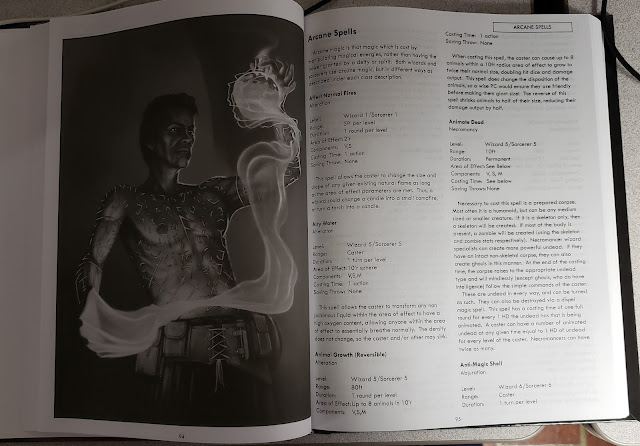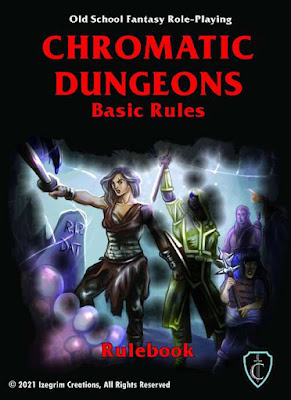Edited to add: Here are all the parts to this series: Part 1, Part 2, Part 3, and Part 4.
Today I want to cover the big game in the Chromatic Dungeons line. I call it the "Advanced" game, but the name on the cover is just Chromatic Dungeons RPG.
Note. I do want to point out that nowhere in the game nor in any online conversation has Roderic Waibel or Izegrim Creations called these rules "Advanced." This is just what I am calling them to differentiate them from the Basic Rules.
Again for this review, I am considering the hardcover I got as a Kickstarter Backer and the PDF from DriveThruRPG.
Note 2: I'll make allusions to the Basic game here. This is only to describe how these rules go above and beyond the basic rules. At no point in these rules did I see something that had you refer to the Basic rules for more details. This rulebook is complete on its own.
330 pages, hardcover, color cover art, black & white interior art.
If the Basic Game was meant to invoke feelings of the 1981 Moldvay Basic set then this book is clearly influenced by the earlier AD&D 1st Edition core rules. It is a hardcover for starters, larger, and provides more details for playing a CD game.
The rules are largely in line with and much more compatible with each other than say Basic D&D was to AD&D. This is one of the biggest reasons I was excited about this particular game. Back in the day we played D&D and AD&D interchangeably and tried to deal with the rule contradictions the very best we could. Here those contradictions do not exist except in the way that specific rules override general ones. Characters are more detailed, as are spells, monsters, and a host of other options, but never in a way they feel contradictory to the Basic Rules. Characters can move fairly freely between the games.
Ability Scores are chosen the same way 4d6 and drop the lowest. Here the general modifiers of the Basic game give way to specific ones for each ability and subscores, ie. to hit and damage adjustment for Strength, number of spells for Intelligence, followers for Charisma, and so on. Ability Checks are handled in the same fashion. Scores still cap at 18 for rolls or 20 with bonuses, but the charts go to 25 for the use of exceptional characters and monsters.
Ancestry covers what species you were born into. Dwarves come in Hill, Mountain, and Deep varieties. Elves can be High, Wood, or Deep. Humans and Halflings are back and joined by Gnomes. A table of alternate Ancestries is also given so you could play Gnolls, Centaurs, Orcs, or Goblins to name but a few. The system is simple enough that almost any sort of ancestry can be used.
Heritage, like the Basic game, covers the character's upbringing. This chart is the same as the Basic game, but expanded with more types.
Character Classes. This is the first of the really big changes. Where the Basic game has only three basic character types, this one has four major class groups with many sub-classes underneath. The feeling is that of Astonishing Swordsmen & Sorcerers of Hyperborea or AD&D 2nd Edition to be honest, with maybe just a touch of 5th Edition D&D. Each group shares an advancement table for HD calculations and to hit bonus along with a shared Saving Throw table. All groups share the same single XP per level table as per D&D 3rd through 5th Editions.
The first group is the Divine, which gives us Clerics and Druids. Divine Spellcasters are limited to 7th level spells. Warriors include the fighter, berserker, ranger, and paladin. Rogues are the most diverse lot with thieves, assassins, bards, and monks. Magic-users are arcane spellcasters and they get spells to 9th level. They include the Wizard and the Sorcerer which is a spell-point-based spell caster. Like the sorcerers of 3rd to 5th edition, they have a bloodline and some examples are detailed.
Multiclassing and Alignment are the same here as the Basic game. The unified XP chart makes multiclassing easier. Alignment is a three-point system of Law-Neutrality-Chaos.
Equipment is next. Very similar but expanded over the Basic game.
Spells is the next largest section of the book and also one of the three that gets the most changes. Spells are split out into classes with the Divine first (Cleric then Druid) then all the Arcane spells. The spells are all listed out alphabetically. Included now are staples like Area of Effect, Components, casting time, and saving throws. Each spell also has a school listed.
How to Play covers the game. This is roughly similar to the Basic Game, but it is expanded. Saving Throws are now added to the game. They are an interesting remix of Basic/AD&D and D&D3 style saves. More on traps, diseases, and hirelings are covered here.
Combat gets its own section. Here initiative is back to a d20 (not the d10 of the Basic game).
The Campaign deals with adventures, granting XP and what kinds of monsters can be found where. It ends with a sample play session.
The Bestiary is the last of the three big changes. Not only are all the monsters expanded on, but there are also more of them. The monsters are still sorted by categories or groups, but now there are more. There are Beasts, Demons, Devils, Dinosaurs, Dragons, Elementals, Fey, Giants, Golems, Humanoids, Lycanthropes, Monstrosities, Oozes, and Undead. The stat blocks are expanded to give average scores for Strength, Intelligence, Wisdom, Dexterity, Constitution, and Charisma. Special Attacks. Special Defenses and Magic Resistance are all now included.
As with the Basic game, many monsters do not have an alignment. Or rather their alignment is listed as n/a. In the case of animals (Beasts and Dinosaurs), it is because they lack intelligence or awareness. Others like humanoids it is because the Game Master can choose what they want. Notably, all Demons and Devils are Chaotic, Dragons are split between Lawful and Chaotic along the lines you think they are, Elementals are now properly Neutral, and Fey runs the spectrum. We get the usual suspects here, nothing jumping out at me as new save for the Mi-Go (not new, but not usual) and the mushropod (sorta new, but certainly NOT usual).
The Treasure section is also expanded. Included new are Sentient Weapons and rarity tables. There is a new section on crafting items including an ingredient listing with measures of rarity.
We end with appendices of tables, blank character sheets, indexes, and our OGL statement.
The PDF is fully bookmarked.
Like the Basic books, this book is filled with evocative old-school style art. Some of it is from various stock art artists the Old-School community knows, but a good deal is original and new art. Much of it is clearly influenced by 40 years of playing. The art goes beyond "Euro-centric" D&D art and a variety of ethnicities, genders, and peoples are represented.
Again like the Basic books this is really directed at and written for people coming into the Old-School RPG scene anew. While there is a lot to enjoy here if you are an old Grog, and the art, in this case, is a particular treat, the audience that will get the most out of this are a generation younger. If you still have your original D&D books from the 1970s and 80s you will still find enjoyment here. Especially if you are like me and enjoy seeing the design choices of "D&D's Greatest Hits" here.
The book "feels" like AD&D 1st Ed. Or maybe it is a 2nd Edition clone if that game had been produced later.
Because of how it is built it also feels like nearly anything can be used with it from nearly any area of D&D's history.
Who Should Buy This?
I said this yesterday about the Basic Chromatic Dungeons game, and it is true for this version as well. This game is a great game to introduce new players, new to RPGs or new to Old-School style games, to the ways of playing of the 1980s. Sure it is not exactly how we did it, but it is a great compromise between Old and New school. Finally, someone has made a "Basic" game that works great as an introduction to an "Advanced" game and one that works well enough on its own. Yes, yes there is Old-School Essentials and Labyrinth Lord that have both Basic and Advanced options, but Chromatic Dungeons' Basic game is truly that, an introductory game, "Basic" and "basic" at the same time and it is the perfect introduction to this "Advanced" game.
If you are like me and grew up on old-school games and now have a family that loves the newest version of the game then this is a good way to introduce them to old-school play. OR if you are new school player and want to try your hand at some old school play, but want to retain some of the options that make the new games so attractive, then this is a great game for you.
--
I am posting this as part of this month's RPG Blog Carnival on Indie Games hosted by The Rat Hole.
























